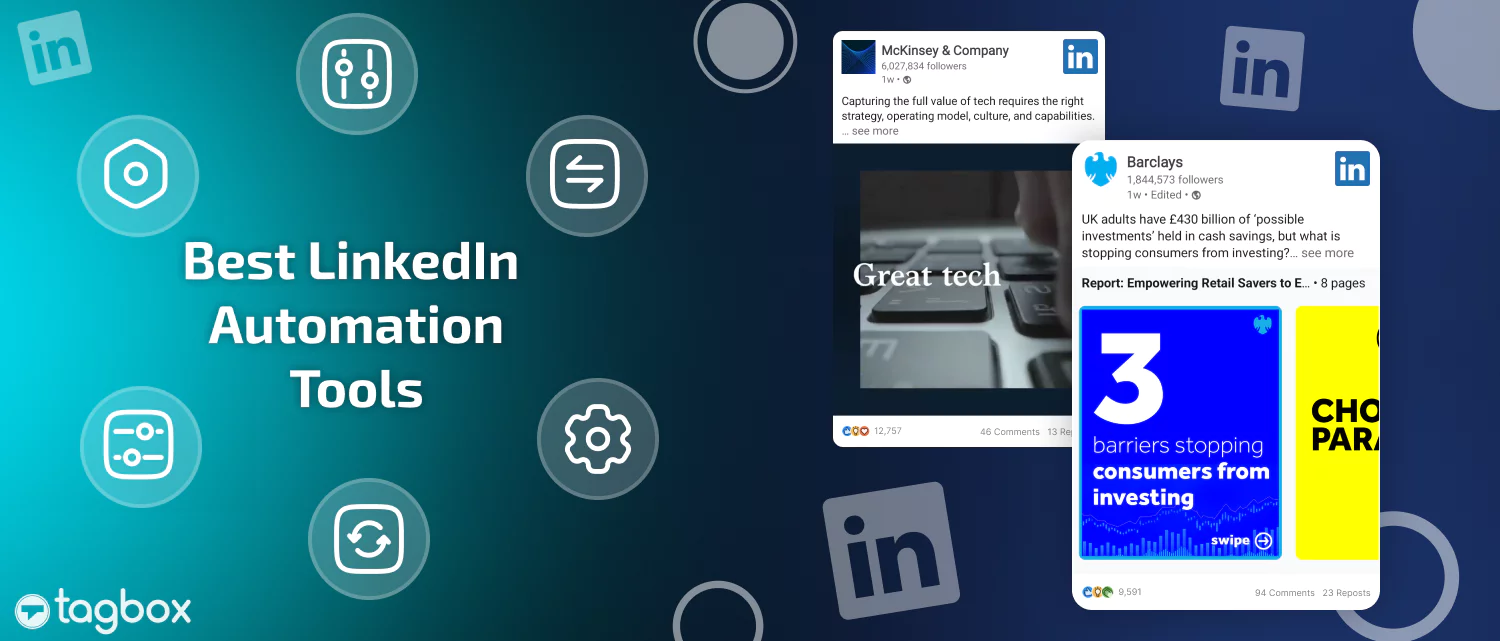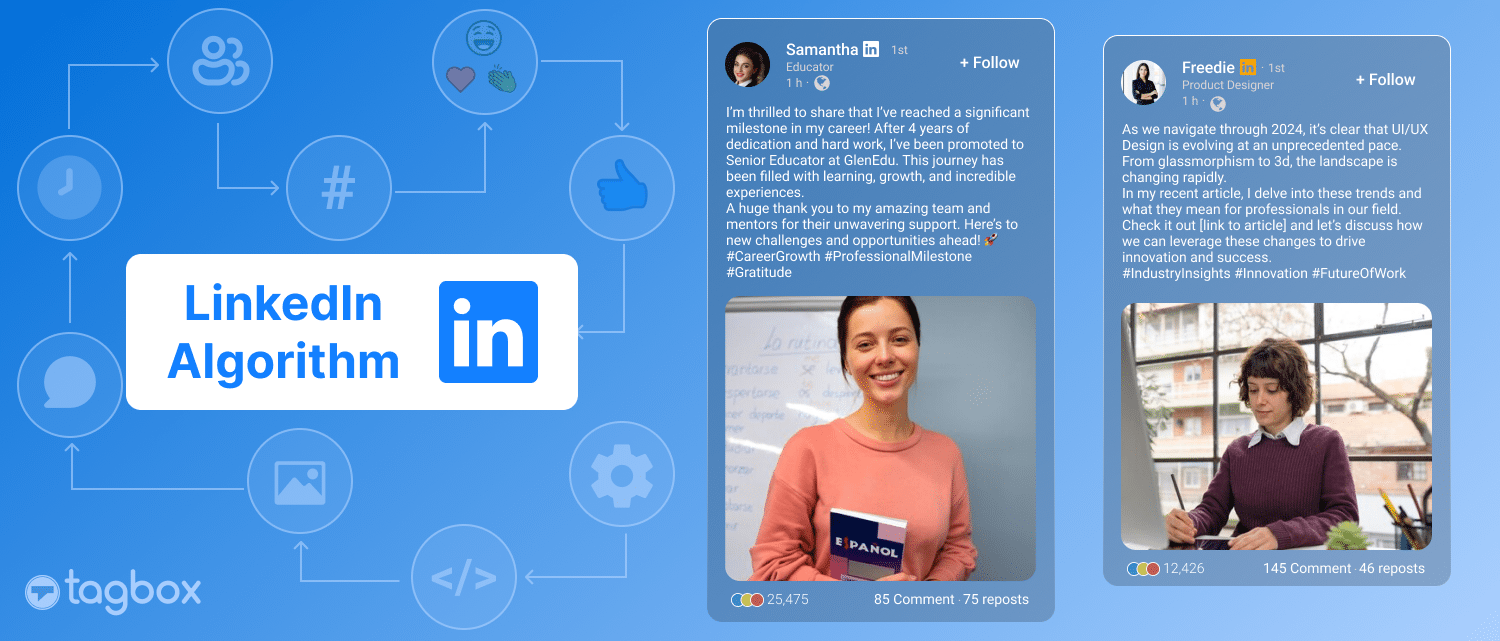Read summarized version with
TikTok vs. Instagram, what really is the difference between these two leading social media platforms? Are you planning a social strategy and wondering which platform suits your brand? Let me walk you through it and help you decide.
Instagram and TikTok have been leading platforms. According to Taggbox, both platforms are trendy when it comes to collaborating with tiktok influencers and other social media marketing efforts, even after having very different audiences.
How is TikTok Different from Instagram?
Regarding social media platforms for marketing, TikTok and Instagram stand out as two giants in the field. Both of them differ significantly in content formats, audiences, and strengths.
TikTok focuses on short, music-driven videos and appeals to a younger demographic. Instagram offers diverse content types for a broader age range, empowering brands to tailor their strategies.
While TikTok encourages authenticity and virality, Instagram emphasizes visual storytelling and established influencer culture.
TikTok vs Instagram: Content Formats
Below is a preview of the in-depth comparison between TikTok and Instagram, highlighting the basic differences between these platforms and their features.
| Aspect | TikTok | |
| Content Formats | Short, music-driven videos (15-60 seconds) | Diverse: posts, Stories, Reels. |
| Target Audience | Primarily younger (16-24) demographic | Broader age range, teenagers to adults |
| Use Cases | Authenticity, viral potential | Visual storytelling, influencer culture |
| Strengths | Authenticity, virality potential | Visual appeal, established user base |
| Engagement Patterns | “For You Page” algorithm-driven | Algorithm-based feed and Explore page |
| User-Generated Content | Emphasis on challenges and creativity | UGC complements brand narratives |
| Advertising Opportunities | TikTok Ads (In-Feed, TopView, Challenges) | Instagram Ads (Feed, Stories, Explore) |
| Targeting Capabilities | Demographics, interests, behavior | Demographics, interests, Custom Audiences |
| Cost-Effectiveness | Cost-effective advertising options | Various ad formats to suit budgets |
| Influencer Marketing | Influencers play a pivotal role | Influencers hold credibility and influence |
| Brand Authenticity and Voice Emphasized | through creativity | through various content |
The significant difference when it comes to TikTok and Instagram is the content formats offered by both of these big players.
Content formats are pivotal for crafting an effective strategy. These platforms offer distinct ways for businesses to engage with their audience, each with its own strengths and potential.
1. TikTok’s Short-Form Videos
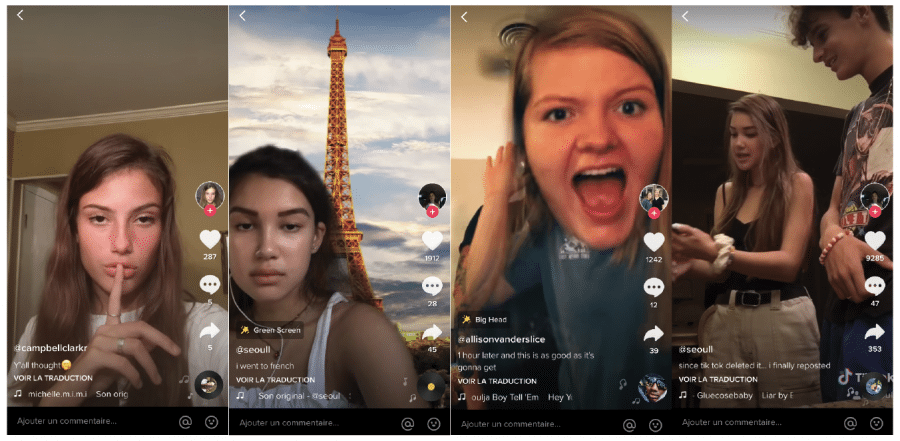
TikTok’s hallmark is its short-form video format, lasting from 15 to 60 seconds. This brevity encourages creativity and efficiency in delivering a message or concept.
The platform’s emphasis on sound, music, and visual effects lends to engaging storytelling.
Businesses can leverage TikTok to create entertaining, visually captivating content that resonates with a younger audience. Its quick, immersive videos are ideal for showcasing products, behind-the-scenes glimpses, and participating in trending challenges.
Check this also – How to Repost on TikTok
2. Instagram’s Array of Content Types
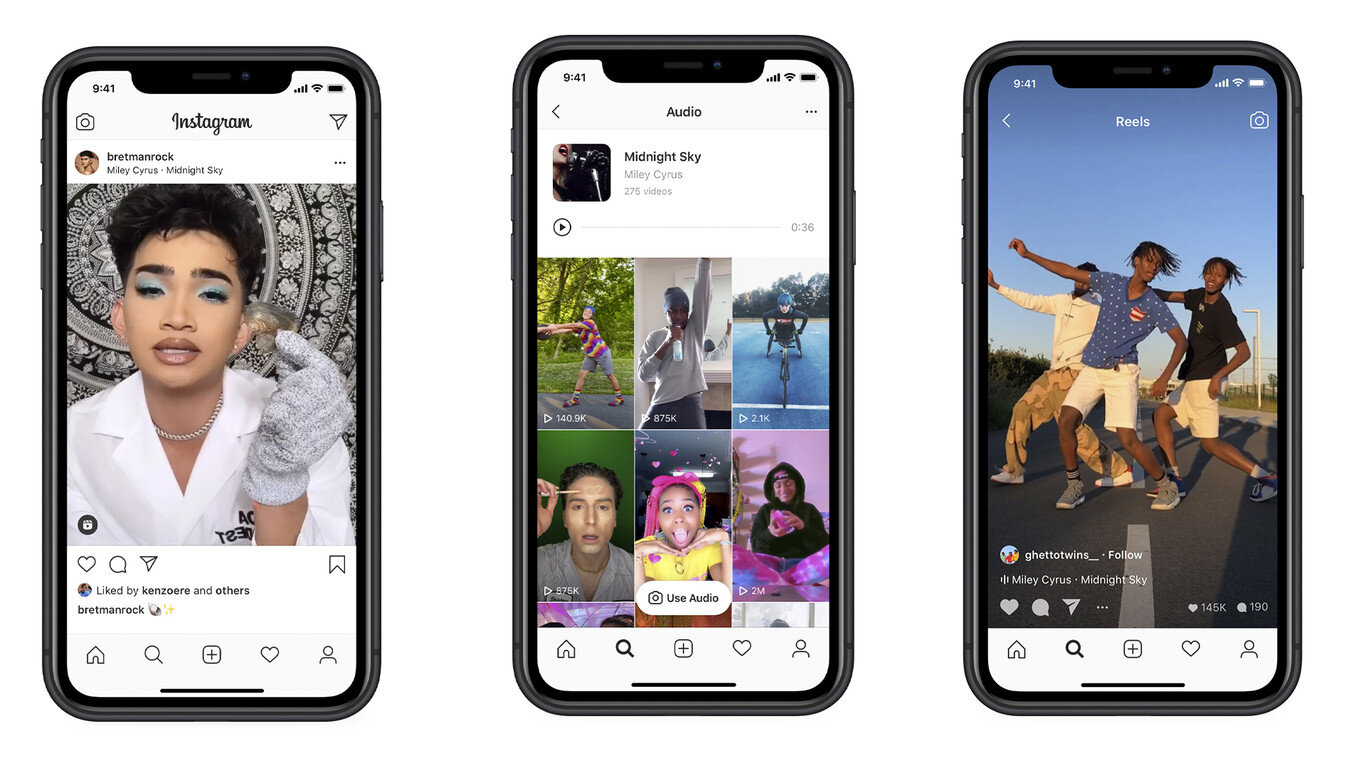
Instagram takes a more comprehensive approach with a range of content formats:
- Posts,
- Stories,
- Reels
Regular posts enable brands to share polished visuals, long-form captions, and hashtags for discoverability.
Instagram Stories provide a temporary, immersive experience with features like polls, questions, and swipe-up links, making them great for limited-time promotions.
Reels, inspired by TikTok, let brands showcase creativity in short video clips.
3. Catering to Different Business Strategies
The unique formats on TikTok and Instagram cater to various business marketing strategies.
For brands seeking quick engagement and rapid awareness, TikTok’s bite-sized videos encourage participation in trends and challenges, quickly establishing a brand presence.
Instagram’s diverse content types offer versatility, enabling businesses to tell their story in multiple ways.
Regular posts exhibit brand aesthetics, Stories enable time-sensitive promotions, and Reels foster creativity.
In conclusion, TikTok’s focus on short-form video content excels at entertaining and engaging younger audiences, including those who may have TikTok’s parental controls activated.
In contrast, Instagram’s array of content formats provides a comprehensive toolkit for reaching a broader demographic. Choosing the right platform depends on your target audience, the nature of your business, and the kind of content you wish to create This will help you stay unique in the competition, including staying updated on the latest viral Instagram marketing trends.
Choosing the right platform depends on your target audience, the nature of your business, and the kind of content you wish to create.
Integrating both platforms into your marketing strategy can yield a dynamic and well-rounded approach, ensuring you effectively connect with your audience regardless of their preferences.
Explore More – How to Repost a Story on Instagram
TikTok vs. Instagram Reels
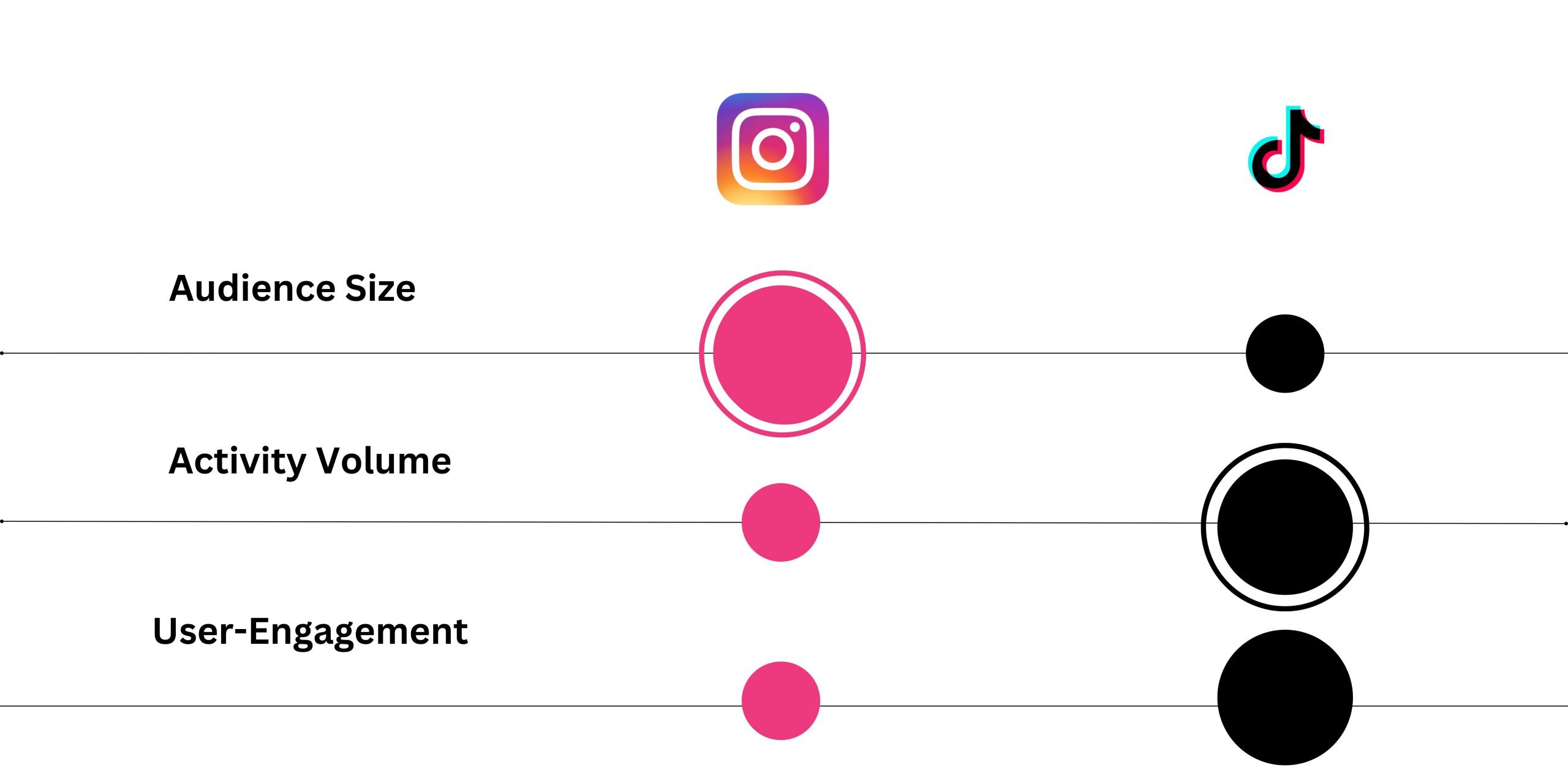
In social media marketing, short-form videos have reshaped how brands connect with their audiences. TikTok and Instagram Reels, both embracing this trend, have become powerful platforms for creative expression and brand engagement.
Let’s delve into the world of these short videos, comparing their features, exploring their potential, and highlighting innovative marketing strategies.
1. Exploring Short-Form Videos on TikTok and Instagram Reels
Short-form videos are bite-sized content that delivers messages quickly, capturing attention and sparking engagement.
TikTok was the creator of this format, offering videos that range from 15 to 60 seconds. Instagram swiftly followed with Reels, allowing users to create 15 to 60-second videos set to music or sound bites. Although now Instagram Reels can be 90 minutes long, according to the latest announcement by Adam Mosseri (Head of Instagram).
Both platforms aim to captivate audiences with concise yet impactful content, encouraging creativity and authenticity.
2. Comparing Features, Duration, and Editing Options
TikTok and Instagram Reels share a similar foundation, but their features and nuances set them apart. TikTok boasts a robust suite of creative tools, including effects, filters, and a vast music library for users to enhance their content.
On the other hand, Instagram Reels integrates seamlessly into the existing Instagram ecosystem, allowing users to tap into the platform’s massive user base.
Regarding video duration, TikTok’s flexibility extends to the full minute, offering creators more room for elaborate storytelling. Instagram Reels, meanwhile, maintains a 90-second maximum, encouraging content that gets straight to the point.
3. Creative Marketing Strategies on Reels and TikTok
Brands have seized the opportunity to connect with their audience through short-form videos on both TikTok and Instagram Reels. They are crafting engaging narratives, sharing product tutorials, and even conducting mini Q&A sessions, all within the brief video time frame.
TikTok’s trend-driven nature invites brands to participate in challenges that align with their identity. These challenges help brands foster engagement and build a community around shared values. On Instagram Reels, brands often tap into the visual appeal of the platform, creating eye-catching content that resonates with users scrolling through their feeds.
4. Innovative Approaches for Marketing Success
Brands have showcased remarkable creativity in their short-form video marketing strategies. Whether showcasing a product in action, sharing quick tips, or crafting amusing skits, these platforms provide ample room for brand expression.
Many businesses have harnessed the power of user-generated content, encouraging customers to share their experiences through short videos.
The authenticity and entertainment value offered by TikTok and Instagram Reels has proven instrumental in building brand affinity. With the potential for content to go viral and reach a broader audience, these platforms drive brand visibility like never before.
Audience Engagement and Interaction:
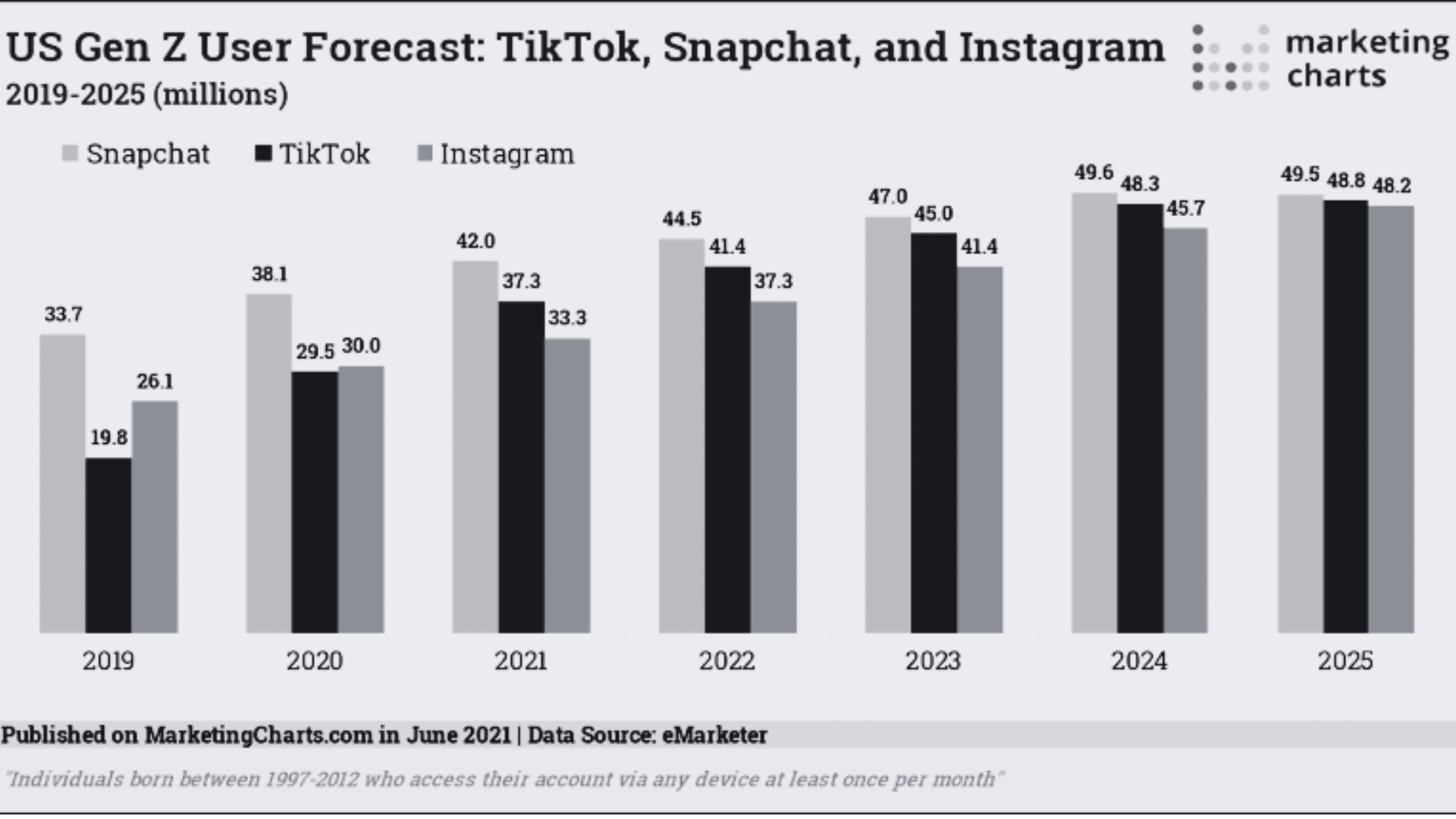
The success of social media marketing hinges on engagement and interaction with the audience. TikTok and Instagram, two prominent platforms in this landscape, offer distinct ways for brands to connect with their followers.
Let’s examine the engagement patterns and interaction methods of these platforms, highlighting their distinct approaches to fostering meaningful connections.
1. Engagement Patterns on TikTok and Instagram
TikTok is renowned for its immersive engagement patterns. The platform’s “For You Page” algorithm introduces users to content from creators they may not be following, expanding content discovery. This algorithm-driven approach means that engaging, creative content has the potential to reach a wider audience rapidly, driving up engagement rates.
On the other hand, Instagram operates on a combination of chronological and algorithm-based feeds. While the “Explore” page showcases content from accounts users don’t follow, the main feed primarily displays content from those they do. Instagram Stories and Reels are displayed at the top of the feed, encouraging users to engage with dynamic, short-form content.
2. User-Generated Content and Challenges on TikTok
TikTok’s unique strength lies in its emphasis on user-generated content and the challenges it presents. These challenges often go viral, sparking widespread participation and engagement.
Brands can tap into this trend by creating their own challenges and encouraging users to create content related to their products or services.
This strategy fosters engagement and nurtures a sense of community around the brand.
3. Interactive Features on Instagram
Instagram thrives on interactive features that enhance engagement.
- Polls,
- questions, and
- quizzes
In Instagram Stories, enable brands to solicit feedback, conduct surveys, and create interactive narratives.
These features humanize brands, inviting followers to participate and feel invested in the content. Additionally, shopping tags in posts and Stories allow businesses to seamlessly integrate e-commerce elements into their content, making it easier for users to explore and purchase products. Hence, as a brand, if you want to leverage Instagram for social commerce, you can start by building trust for your products. You have the option of getting some likes from reliable sites to boost your social proof.
4. Strategies for Maximizing Engagement
On TikTok, brands can leverage trending challenges or create original ones, encouraging users to participate by using specific hashtags.
By showcasing user-generated content in their successful campaigns, brands can build authenticity and strengthen their connection with the audience.
Instagram’s interactive features can be harnessed for Q&A sessions, behind-the-scenes glimpses, and crowd-sourced content ideas.
The shopping tags primarily provide a seamless shopping experience, reducing friction between inspiration and the purchasing process.
Read More – How to Repost on Instagram
Algorithm and Discoverability:
Understanding the algorithms of social media platforms is essential for maximizing content visibility and engagement.
TikTok’s “For You Page” and Instagram’s feed and Explore page algorithms are pivotal in shaping user experiences.
Let’s delve into how these algorithms work, their impact on content discoverability, and strategies for brands to optimize their content for broader reach.
1. TikTok’s Algorithm-Driven “For You Page”

TikTok’s “For You Page” (FYP) is the heart of its algorithm-driven content discovery. The FYP curates a personalized TikTok feed based on user interactions, preferences, and behaviors.
The algorithm notes when users engage with content by liking, sharing, or watching to the end. It then presents users with similar content from UGC content creators they may not follow but are likely to enjoy. This dynamic approach to content delivery has catapulted lesser-known creators into the limelight, promoting inclusivity and virality.
2. Impact on Content Discoverability
TikTok’s algorithm democratizes content discoverability. Regardless of follower count or celebrity status, any user’s content has the potential to reach a vast audience.
This levels the playing field for brands, allowing creative and engaging content to capture attention and generate views rapidly.
3. Instagram’s Algorithm for Feed and Explore Page

Instagram’s feed and Explore page algorithm considers several factors to determine content visibility.
Engagement history, relationship with the user, timeliness of the post, and the user’s interests all influence the content shown.
The Explore page showcases content based on user interests, encouraging users to discover new accounts and interests.
4. Optimizing Content for Visibility
For TikTok, creating engaging, high-quality content is key.
- Consistency matters; regular posting helps the algorithm understand the creator’s style and audience preferences, which is essential for attracting high-quality TikTok likes.
- Utilizing trending sounds, challenges, and relevant hashtags can increase the chances of content being featured on the FYP.
On Instagram, compelling visuals and captions are essential.
- High-quality images and well-crafted captions draw users in.
- Engagement—such as likes, comments, and shares—significantly boosts content higher in users’ feeds. Using relevant hashtags, posting at optimal times, and fostering interactions through
- Stories and engagement-driven posts can improve discoverability.
Metrics and Analytics:

Measuring the effectiveness of your social media efforts is crucial for refining your marketing strategy. If you want to manage everything in one place, SocialBee is a TikTok and Instagram analytics tool that lets you track performance, monitor growth, and schedule posts, all from one platform. Let’s delve into the available metrics on these platforms, how businesses can gauge their success, and provide insights into average engagement rates, reach, and click-through rates for business accounts. Let’s delve into the available metrics on these platforms, how businesses can gauge their success, and provide insights into average engagement rates, reach, and click-through rates for business accounts.
1. Metrics on TikTok and Instagram
TikTok’s analytics center on the profile, content, and follower metrics. Creators can access video views, likes, shares, comments, and follower growth data. Additionally, TikTok offers insights into the audience’s demographics, helping brands refine their targeting to increase more TikTok followers.
Instagram’s Insights provides a wealth of information for business accounts. Metrics cover profile visits, follower growth, reach, and engagement for posts and Stories. Instagram also offers data on the audience’s demographics, enabling businesses to tailor their content strategy.
2. Tracking Performance, Reach, and Engagement
For TikTok, tracking performance involves analyzing video views, likes, comments, and shares. Understanding which content resonates the most can guide content creation. Monitoring follower growth and audience demographics helps refine targeting strategies.
On Instagram, gauging performance encompasses evaluating likes, comments, and shares on posts and Stories. Tracking follower growth, reach, and impressions provides insights into the content’s reach and engagement levels. Examining demographics and engagement data helps optimize content for the target audience.
3. Average Engagement Rates, Reach, and Click-Through Rates
On TikTok, average engagement rates vary but typically range from 3% to 9%, encompassing likes, comments, and shares. The average reach for a TikTok video can span from thousands to millions of views, depending on factors such as content quality and its potential for virality.
Instagram’s engagement rates range from 1% to 5% for posts and 3% to 7% for Stories. The average reach for a post or Story depends on the number of followers and the algorithm’s assessment of content relevance. Click-through rates for the swipe-up feature in Instagram Stories average around 15% to 25%.
Advertising and Marketing Opportunities:
In the competitive world of digital marketing, TikTok and Instagram stand as formidable platforms, each offering unique advertising opportunities.
Let’s explore the advertising options, targeting capabilities, ad formats, and cost-effectiveness of both platforms.
1. TikTok Ads: Unleashing Creativity
TikTok Ads empower brands to engage users through visually captivating and entertaining content. Advertisers can choose from several ad formats, including In-Feed Ads that seamlessly integrate into the “For You Page,” TopView UGC Ads that command attention as the first thing users see, and Branded Hashtag Challenges that encourage user participation. These formats enable brands to harness the platform’s creativity and virality.
2. Targeting Capabilities and Ad Formats on TikTok
TikTok’s targeting capabilities encompass demographics, interests, and behavior, enabling advertisers to reach their desired audience effectively. Advertisers can also leverage Lookalike Audiences to expand their reach. The platform supports a wide range of video and image formats, ensuring versatility in campaign execution.
3. Instagram Ads: Harnessing Visual Appeal
Instagram Ads capitalize on the platform’s visual-centric nature, offering brands a diverse range of ad formats. Feed Ads, Stories Ads, and Explore Ads enable businesses to connect with users throughout their browsing experience. These formats allow brands to craft visually appealing, immersive narratives that resonate with their target audience.
4. Targeting Capabilities and Ad Formats on Instagram
Instagram’s extensive targeting options encompass demographics, interests, behaviors, and even advanced targeting options, such as Custom Audiences and Lookalike Audiences. Advertisers can choose from single-image, carousel, video, and slideshow formats, tailoring their content to their audience’s preferences.
5. Cost-Effectiveness and Examples of Successful Campaigns
TikTok and Instagram offer cost-effective advertising options for businesses of all sizes. The cost per click (CPC) and cost per thousand impressions (CPM) vary based on factors such as ad format, targeting, and competition.
6. Examples of successful brand campaigns include:
- TikTok Campaign Example: E.l.f. Cosmetics’ #EyesLipsFace Challenge

E.l.f. Cosmetics, a well-known beauty brand, executed a highly successful UGC campaign on TikTok using the hashtag challenge #EyesLipsFace. The challenge encouraged users to create and share their own creative videos featuring the brand’s original song that played along with the challenge. Participants showcased quick makeup transformations, highlighting their eyes, lips, and faces to the beat of the music.
This campaign resonated with TikTok’s user base due to its interactive and engaging nature. Users participated in a challenge, leveraging the platform’s creative tools to showcase their makeup skills and creativity.
The campaign’s viral spread led to millions of user-generated videos using the hashtag, collectively contributing to over 3 billion views.
E.l.f. Cosmetics’ campaign demonstrates the power of TikTok’s user-generated content approach. By encouraging users to engage with their products and creatively express themselves actively, the brand achieved massive visibility and engagement, effectively tapping into the platform’s viral potential.
- Instagram Campaign Example: Airbnb’s Stories Campaign

Airbnb, a global hospitality company, utilized Instagram Stories to create a visually captivating and engaging campaign. The campaign featured a series of Stories showcasing unique and stunning stays available on the platform. Each Story provided a glimpse into different Airbnb reviews‘ aesthetics, amenities, and experiences.
The campaign’s success was evident in the 3-point lift in ad recall that Airbnb achieved. The brand effectively engaged users with visually appealing content using Instagram’s immersive Stories format. The campaign leveraged the platform’s vertical, full-screen format, enabling users to swipe through a seamless visual journey of Airbnb’s offerings.
Airbnb’s campaign on Instagram demonstrates how leveraging the platform’s visual-centric features can lead to impactful storytelling. The visual appeal of the content, combined with the immersive Stories format, enabled the brand to capture users’ attention and leave a lasting impression, ultimately driving improved ad recall.
Influencer Marketing and User-Generated Content:
Influencer collaborations and user-generated content are powerful strategies that can significantly enhance a brand’s reach and engagement on social media.
TikTok and Instagram provide unique platforms for brands to tap into the power of influencers and user-generated content.
Let’s explore the significance of influencer marketing, how brands collaborate with influencers, and showcase case studies that highlight the benefits of such partnerships on both platforms.
1. Significance of Influencer Marketing on TikTok and Instagram
Influencers possess the ability to connect authentically with their followers, making them instrumental in building brand awareness and trust.
TikTok and Instagram are breeding grounds for influencers who wield substantial influence over their dedicated audience.
Collaborating with these influencers enables brands to tap into existing communities and leverage their credibility to reach potential customers effectively.
2. Influencer Collaboration and User-Generated Content
Brands collaborate with influencers by partnering with individuals who align with their values and target audience.
These influencers create content that seamlessly integrates the brand’s offerings into their posts, showcasing products authentically and relatable. Conversely, user-generated content is created by customers or fans who share their experiences with the brand’s products or services.
3. Case Studies: Influencer Partnerships on TikTok and Instagram
- TikTok Case Study: Chipotle’s #GuacDance Challenge

Chipotle, the fast-food chain, launched the #GuacDance challenge on TikTok, collaborating with influencers like David Dobrik. The challenge encouraged users to dance while holding an “invisible guacamole bowl.”
This playful challenge garnered over 250,000 user-generated videos and 430 million video starts. The campaign’s success highlighted the potential for viral engagement through influencer-led challenges.
- Instagram Case Study: Daniel Wellington’s Influencer Campaign

Watch brand Daniel Wellington’s influencer campaign on Instagram is a prime example of a successful partnership. Collaborating with influencers across different niches, the brand showcased its watches in various lifestyle settings.
The strategic use of influencers’ visual storytelling enhanced the brand’s image and resonated with its target audience. This campaign highlighted the effectiveness of influencer partnerships in enhancing brand aesthetics and driving engagement.
Brand Presence and Authenticity:
Both TikTok and Instagram provide dynamic platforms for brands to infuse their unique voice, culture, and values into their content.
Let’s explore the significance of authenticity, how businesses can effectively showcase their culture and values through content on both platforms, and examples of brands that have excelled in portraying authenticity.
1. Importance of Authenticity and Voice
Authenticity fosters trust and loyalty among consumers. It humanizes brands, making them relatable and approachable. TikTok and Instagram provide the ideal platform for brands to showcase their genuine personality, thereby resonating with their target audience.
2. Showcasing Culture and Values Through Content
Businesses can leverage various content formats to showcase their culture and values.
- Behind-the-scenes glimpses offer valuable insights into the company’s daily operations, fostering a sense of transparency.
- Employee spotlights showcase the people behind the brand, humanizing it and bringing it to life.
- Sharing user-generated content and engaging in conversations about social and environmental causes aligns with values.
3. Examples of Authenticity on TikTok and Instagram
- TikTok Example: Gymshark’s Fitness Challenges

Gymshark, a fitness apparel brand, engages its audience on TikTok through fitness challenges. These challenges align with the brand’s fitness-oriented culture and inspire users to participate, showcasing their workout routines and progress.
By encouraging users to share authentic, unfiltered workout content, Gymshark effectively embodies authenticity and the fitness lifestyle.
- Instagram Example: Patagonia’s Ethical Values

Patagonia, an outdoor clothing brand, authentically showcases its commitment to ethical and environmental values on its Instagram page.
The brand shares content highlighting its sustainable practices, philanthropic initiatives, and customers’ experiences in the wild.
Patagonia’s content aligns with its core values, resonating deeply with environmentally conscious consumers.
You Get To Choose: TikTok or Instagram
Now that you know both platforms and what they offer, the choice between TikTok and Instagram boils down to aligning platform features with business objectives.
TikTok’s emphasis on authenticity, user-generated content, and trendsetting is a powerhouse for younger audiences seeking engagement and virality. On the other hand, Instagram’s visual versatility, influencer culture, and established user base cater to a broader demographic and varied content strategy.
When selecting a platform, brands should consider their target audience, content style, and marketing goals. A youth-focused brand might thrive on TikTok’s vibrant trends, while a lifestyle brand could leverage Instagram’s visual storytelling.
By understanding the core differences and unique strengths of each platform, businesses can confidently make informed choices that elevate their brand presence, foster authentic connections, and drive marketing success.





